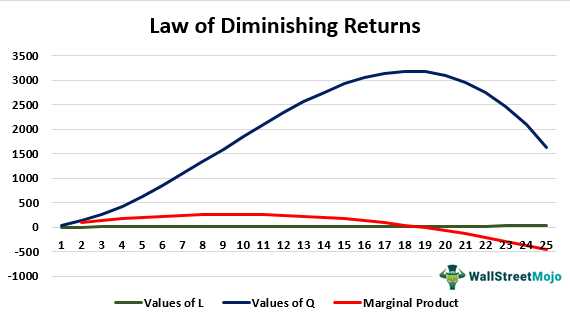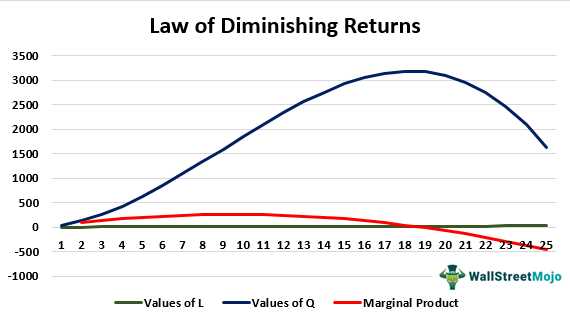Law of Diminishing Marginal Returns: Definition, Example, Use in Economics

The Law of Diminishing Marginal Returns is a fundamental concept in economics that states that as more units of a variable input are added to a fixed input, the marginal product of the variable input will eventually decrease.
Definition
The Law of Diminishing Marginal Returns is based on the principle that as additional units of a variable input are added to a fixed input, the increase in output will eventually become smaller and smaller. This occurs because the fixed input, such as capital or land, cannot be increased in proportion to the variable input, such as labor.
For example, let’s consider a bakery that produces cakes. The bakery has a fixed amount of baking equipment and a variable amount of labor. Initially, as more workers are hired, the bakery’s output increases at an increasing rate. However, at some point, adding more workers becomes less productive. This is because the fixed amount of baking equipment limits the efficiency of the additional labor.
Example
Use in Economics

The Law of Diminishing Marginal Returns has important implications in economics. It helps explain why firms eventually experience diminishing returns to scale, where the increase in output becomes less than proportional to the increase in inputs. This concept is crucial in determining the optimal level of production and resource allocation.
Definition of the Law of Diminishing Marginal Returns
The Law of Diminishing Marginal Returns is an economic concept that states that as more units of a variable input are added to a fixed input, the marginal product of the variable input will eventually decrease. In simpler terms, it means that the additional output gained from each additional unit of input will diminish over time.
This concept is based on the idea that there are limited resources and factors of production available in any given production process. As more units of a variable input, such as labor or capital, are added to a fixed input, such as land or machinery, the productivity of each additional unit of the variable input will decrease.
For example, let’s consider a factory that produces widgets. Initially, the factory has a fixed amount of machinery and a certain number of workers. As more workers are hired, the production of widgets increases. However, at some point, adding more workers may lead to overcrowding and inefficiencies in the production process. The marginal product of each additional worker will start to decline, resulting in diminishing marginal returns.
Factors Affecting the Law of Diminishing Marginal Returns
Several factors can influence the Law of Diminishing Marginal Returns. These include:
- Technology: Advances in technology can help overcome the limitations imposed by diminishing marginal returns. For example, automation and improved machinery can increase productivity and offset the diminishing returns associated with adding more labor.
- Input Quality: The quality of the variable input can also affect the Law of Diminishing Marginal Returns. Higher-skilled workers or better-quality materials may be able to maintain a higher level of productivity even as more units are added.
- Management and Organization: Efficient management and organization can help mitigate the effects of diminishing marginal returns. By optimizing the production process and allocating resources effectively, businesses can delay the onset of diminishing returns.
Implications in Economics
The Law of Diminishing Marginal Returns has important implications in economics. It helps explain why production processes have limits and why increasing inputs indefinitely does not always lead to proportional increases in output.
In summary, the Law of Diminishing Marginal Returns states that as more units of a variable input are added to a fixed input, the marginal product of the variable input will eventually decrease. This concept has implications for businesses, policymakers, and economists, as it helps explain the limits of production processes and the importance of resource allocation and technological advancements.
Example of the Law of Diminishing Marginal Returns
The Law of Diminishing Marginal Returns is a fundamental concept in economics that states that as more units of a variable input are added to a fixed input, the marginal output or productivity of the variable input will eventually decrease.
To understand this concept better, let’s consider an example:
Scenario:
Imagine a small bakery that produces cupcakes. The bakery has a fixed amount of baking equipment, such as ovens and mixers, and a variable input, which is the number of bakers they employ.
With two bakers, the bakery’s cupcake production increases to 200 cupcakes per day. This is because the second baker can assist in mixing the batter, baking the cupcakes, and icing them.
The third baker’s productivity is affected by factors such as limited workspace, coordination issues, and the presence of other bakers. As a result, the bakery’s cupcake production only increases to 250 cupcakes per day with the addition of the third baker.
Now, the bakery decides to hire a fourth baker. However, they find that the workspace becomes crowded, and there is a lack of coordination among the bakers. Consequently, the fourth baker’s productivity is even lower, and the cupcake production only increases to 270 cupcakes per day.
This example illustrates the Law of Diminishing Marginal Returns. As more bakers are added, the marginal increase in cupcake production becomes smaller and smaller. Eventually, the additional bakers start to hinder productivity rather than enhance it.
It is important for businesses to understand this concept as it helps them make informed decisions about the optimal allocation of resources. By recognizing the point of diminishing returns, businesses can avoid overstaffing or overinvesting in a particular input, which can lead to inefficiencies and decreased profitability.
Use of the Law of Diminishing Marginal Returns in Economics
The Law of Diminishing Marginal Returns also has implications for resource allocation in other sectors of the economy. For example, in agriculture, farmers need to consider the optimal amount of fertilizer to use on their crops. Initially, adding more fertilizer may lead to increased crop yields. However, at a certain point, adding more fertilizer may result in diminishing marginal returns, where the additional crop yield gained from each additional unit of fertilizer decreases.

Emily Bibb simplifies finance through bestselling books and articles, bridging complex concepts for everyday understanding. Engaging audiences via social media, she shares insights for financial success. Active in seminars and philanthropy, Bibb aims to create a more financially informed society, driven by her passion for empowering others.
